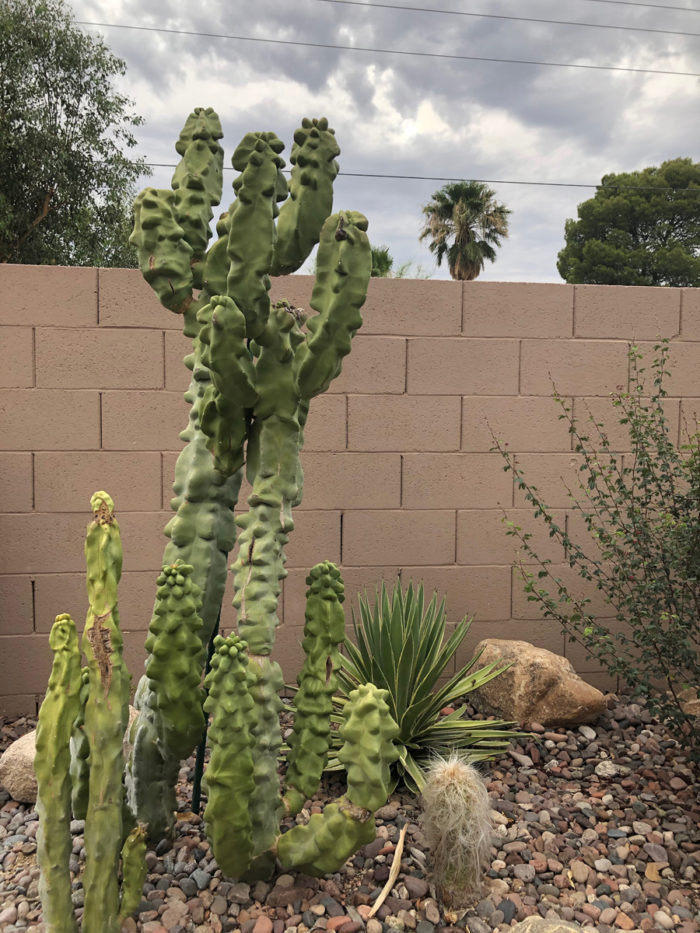
A beautiful thing about cacti is the variety of shapes and sizes you can find for your specific needs and space. We love having a variety of heights in our landscape, which is what makes our addiction to columnar cacti that much more convenient. Columnar cacti are defined as upright, cylinder-shaped cacti which may or may not have branches. A large number of columnar cacti are cereoid or cereus, which describes their elongated bodies.

Saguaro
Carnegiea gigantea, Zones 8–11
The most prevalent and popular columnar cactus in the Southwest is saguaro. Saguaro is a symbol of the desert with lifelike arm “movement” and grand stature. Its limbs often resemble arms and legs, and sometimes it looks like it’s dancing in the desert. Saguaros can grow up to 50 feet tall, but they are very slow growers at 1 to 1.5 inches per year. Their arms or branches start to grow around the age of 50 to 70 years, depending on the climate. In some very low precipitation areas, it can take up to 100 years for an arm to appear. At the age of 35, most saguaros begin producing flowers. The creamy white blooms start to appear in May. In late June and July, the cactus will start fruiting. Considered sacred on the Tohono O’odham native lands here in Arizona, their bahidaj fruit has a deep reddish-pink flesh with black seeds. This beautiful fruit can be used to make jams and syrups similar to the tuna fruit of prickly pear cactus (Opuntia spp. and cvs., Zones 4–10). Planting a young saguaro in your garden may not bring you instant gratification in the form of blooming and branching, but even smaller saguaros possess beauty and strength. Planting one is also a way of passing along that beauty to someone years down the road. A trick to tell if your saguaro needs water is to see if you are unable to stick two fingers between its ribs. The tighter the ribs, the more water it needs.

Silver torch
Cleistocactus strausii, Zones 9–10
Bringing your eyes a bit lower to the ground, silver torch are hairy-looking, fast-growing cacti that are nothing if not unique. They thrive in full sun or partial shade and are drought resistant. Silver torch grow to 6 to 8 feet tall, but the columns are slender. Their almost comedic-looking blooms stand perpendicular from them with a deep red hue, but they never open. Silver torches add a fantastic touch of interest to any garden bed or container garden. Since they are upright growers, they can be planted in smaller spaces or when creating a cactus garden. They add the perfect texture and element of surprise.

Mexican fencepost
Pachycereus marginatus, Zones 9b–11
If you need a bit more privacy in your gardens or yard, consider planting some Mexican fencepost. These extremely low maintenance cacti are slow growing, but given time they can reach up to 20 feet tall. If you’d like to speed up the growth process, add some supplemental water (a biweekly deep watering), but let the soil completely dry out before watering again. The name of this cactus comes from the original use in small towns in Mexico, where these cacti were used as living walls and property dividers. Sturdy clusters of the dark green arms provide a fantastic backdrop for gardens. The spines on the Mexican fencepost are small and look like tailored stitches. When in bloom, Mexican fenceposts produce delicate red flowers followed by a yellow, spiny fruit sometimes called koubo.

Totem
Pachycereus schottii f. monstrosus, Zones 9–10
Last but certainly not least, totem is our all-time favorite cactus. Totems are spineless. How dreamy, right? No pokes, pricks, or blood-stained clothes. Beyond that, they are unpredictable with their growth patterns. Some grow mostly upright, while others grow arms on their arms. I can verify that although they are considered slow growers, when given a bit of supplemental water (again, a biweekly deep watering), they will grow like weeds. They can grow to heights of 10 to 12 feet, although it can take a lifetime to grow that tall. Usually you will see them in the 3-to-6-foot-tall range. Totems produce light pink, night-blooming flowers in late spring. They also can produce a red, egg-shaped fruit. (Since we have never actually seen a totem bloom, this still seems like a bit of an old wives’ tale to us, but we trust the authorities.) Totems not only add a great conversation piece to any garden, but they bring amazing movement with their wild twists and turns. Finally, as with most columnar cactus, totems can be easily propagated. Propagating is an affordable way to help build your garden while at the same time maintaining the shape of existing cacti.
Whether you’re living in the heart of the city with only a balcony for container gardening, or you live with acres of landscape to play with, incorporating some columnar cacti is by far one the best ways to experiment with various heights and textures. We’ve only touched on a handful of possibilities, but there are so many more to learn about. Be sure to look around next time you’re at your local nursery. Maybe you can find a fun columnar piece for your space.
—Sheila Schultz and Laurel Startzel are a mother-daughter duo who founded Denver Dirty Girls Container Gardening while living in Denver and have continued their business since moving to Tucson, Arizona.


















Comments
Log in or create an account to post a comment.
Sign up Log in